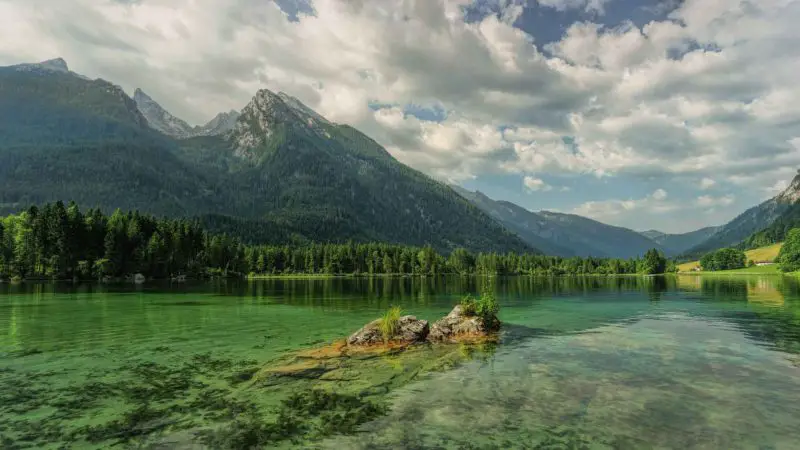Climbing as a sport is getting increasingly popular. Whether you climb indoors in one of the hundreds of climbing gyms in North America or outdoors, it can be both fun and safe if done with proper equipment and technique. But, it’s worth mentioning that we, as climbers have a moral obligation to respect the environment. Even when bouldering indoors, you’ll want to breathe in the fresh air and venture to the beautiful outdoors at some point, which begs the question of how you can become a more eco-friendly climber by limiting your impact on the rocks you’re conquering as well as the animals and vegetation. Here is everything you need to know to enjoy your climb in a responsible manner.
1- Gently scrub your chalk off before departing
Climbing chalk, which is used made from magnesium carbonate, is used to absorb moisture from your hands while you climb, giving you a better grip on the climbing holds; more on that in my climbing chalk post. Ideally, the chalk you use should not get outside in the environment. At high temperatures, magnesium carbonate will decompose in magnesium oxide and carbon dioxide. Our atmosphere is already loaded with carbon dioxide, so every small step we take to diminish the amount of carbon dioxide is welcome. Hence, you should use climbing chalk wisely and don’t forget to gently scrub it off the climbing holds using a climbing brush, like this one by Escape climbing.
2- Remove old bolts
Metal waste is one of the most challenging kinds of waste to manage. It rusts fairly quickly, contaminating soil and water. Heavy metal contamination affects everyone and everything, be it plants, animals, or humans. If every climber were to use different bolts or lose them, their number would end up in the wrong place will begin increasing. Bolts are dangerous to the environment because as they oxidize, they release metal into the soil. From there, it can seep into the water supply, rendering it toxic. If we are to protect the environment, we should take one small step at a time, beginning with the most ubiquitous of things.
3- Choose durable surfaces when traveling and camping
In case you plan to go on a climbing trip, you should plan well ahead, so as to make sure you do it in a responsible manner. Consider that you are a guest of nature, so make sure not to disturb the balance of the ecosystem while enjoying a good climb. Choosing the spot where you set camp is more important than you may think. Don’t pick a spot at random, just because you think it looks nice. Be a thoughtful and responsible by opting for durable spots for your campsite. This means that you should avoid meadows, areas with vegetation, or places that are close to rivers or lakes. In fact, your camp should be at least 200 feet away from any water source, to avoid accidental contamination. Areas with dry grass, gravel, rock, or the ones specially created for camping are the most recommended in this case. When exploring the wilderness, try to stick to frequently used trails instead of carving your way through areas that were not yet explored. So, the advice here is to be minimally invasive. The whole idea is to make your presence unnoticed while enjoying nature.
4- Properly dispose of your waste
As you prepare for your outdoor climbing adventure, one thing is certain… you’ll need a lot of gear from your basic equipment to food, protective gear, and so on. Inevitably, you’ll produce a good amount of waste. The most frequent kind, in this case, will be the waste generated from food packaging; be it bottles, cans, and food leftovers among other things you’ll have to manage properly. Make sure to properly dispose of everything you brought along with, as you leave the campsite. Simply, pack it in and make sure there is no risk for spilling it. Also, don’t leave the campsite without a thorough inspection. But what about solid human waste on a climbing trip? It’s not a good idea to just do your duty wherever you may find a suitable spot. Catholes, on the other hand, are a great solution. They should have a depth of 6 to 8 feet and should always be covered with dirt before your departure. The hygiene products you use, like toilet paper, should not be thrown in the cathole, but packed and carried away, like the rest of the waste you produce. If you have dishes that need washing, make sure to always use biodegradable soap.
5- Use sustainable gear while climbing
When shopping for climbing gear, pay attention to the materials used for the making of those products. Although it might not look like it, but the items you use can release certain toxic compounds or be produced in an unsustainable manner. What to avoid when looking for sustainable climbing gear? Try to stay away from products containing PFCs, as they are harmful to the environment and can turn into greenhouse gases in certain conditions. Instead, focus on buying gear made out of recycled materials, such as polyester and organic materials, like organic cotton. Considering that climbing shoes are made out of leather and marketed as being more durable and comfortable, you might want to opt for synthetic shoes in this case, which is the animal-friendly alternative. PrAna or Alpkit are two brands known for using organic cotton when it comes to climbing gear. Even the sunglasses you use can be eco-friendly, like the ones from Zeal Optics. Instead of plastic, they are made out of castor beans.
6- Only buy what you need
Before heading out to the mountains, take a moment to make a list with all the things you’ll need on your climbing trip. After you’re done writing your list, decide which of those items you don’t really need. This will not only be good for the environment, but also for your budget. After a close assessment, you will be surprised how many things you actually don’t need. So, keep your backpack light and grab only the things you can’t do without. This will also mean that you’ll be generating less waste, which you’d eventually have to carry back with you.
7- Use cold water when washing your clothes
You may be tempted to wash your climbing clothes with hot water, to better remove the grime. But, if you wash your clothes after each use, cold water will do the trick. Washing clothes with cold water each time will reduce your energy consumption. If you use a good detergent and don’t stuff the washing machine with clothes, cold water will get the job done. Also, most modern washing machines have eco-friendly washing programs, which are set up to save both, water and energy. You may have to invest a little bit more to get a more modern washer, but you’ll notice a lower energy bill once you start using it.
8- Don’t go off trail
The best way to make sure that your experience in the outdoors won’t disturb the ecosystem is to stay on by staying on the trail. You should stick to this advice not only when you’re on the move, but also when setting camp. Green meadows or spots near a lake can appear attractive, but your mere presence there will have an impact on the fragile ecosystem. So, be respectful and admire them from a far. After all, we’re all guests, so treat every fellow climber, plant and animal with respect and consideration.
9- Don’t clear out any bushes to place your climbing gear
Even the rocks you will climb on are homes for a wide variety of creatures. Birds have nests among rock boulders, but reptiles and small rodents can also seek shelter in a rocky landscape. So, try to resist pulling away any forms of vegetation you come across while climbing, even if it’s dry. Boulderers usually have the bad habit of clearing out bushes underneath their climbs, to make it easier to position their pads. There are a few alternatives; you could either pick a better spot or simply tie a branch with a string to gently pull it to the side, in order to place your climbing pad, however, you should be very gentle, so as to avoid damaging or uprooting the plant.
10- Contain your campfire
Campfires are good for cooking and warmth, but you should always minimize their impact. For example, if you’re camping in a set campsite, use existing fire rings to make a fire, instead of making your own. If there are no fire rings in your camping area, choose to make a mound fire. Also, when making your fire, try to keep it as small as possible, after all, it’s just used for cooking. When fueling your fire, do it responsibly and make sure all the wood you used burns to ash before leaving the campsite. When it comes to firewood, don’t cut off any tree branches, even if they appear to be dead. Gather only what you can find on the forest floor and choose pieces that aren’t larger than your wrist. Once every piece of wood burned entirely, use water to make sure the ashes are cold. Then gather the remaining cool ashes and scatter it over a large area.
11- Use public transportation whenever possible
We can all reduce fuel consumption, CO2 emission, and toxic fumes by using public transportation as often as possible. Also, avoid traveling by plane, due to their extreme fuel consumption and CO2 emissions. But doing so is heavily dependent on your climbing location and gear. So, driving might be a viable solution, especially when traveling with your climbing partners.
12- Become a member of the Access Fund
Joining the access fund is another great way to help protect the environment, it’s the largest climbing advocacy movement in America and has our best interests as climbers and nature lovers at heart. The access fund works on matters such as land acquisition and protection, stewardship and conservation, risk management and landowner support, and it even pushes land policy efforts in D.C., these are just a few of their good deeds, you can learn more about the access fund here. You could support the movement with a donation, which can offer a slew of membership perks; alternatively, you can opt for one of the numerous volunteering opportunities such as trail clean-up.
Thanks for reading this article, I’d love to read your thoughts about this topic. If you have any idea to better preserve the outdoors as a climber, leave me a comment below and don’t forget to share this article with your friend.
Climb on!

